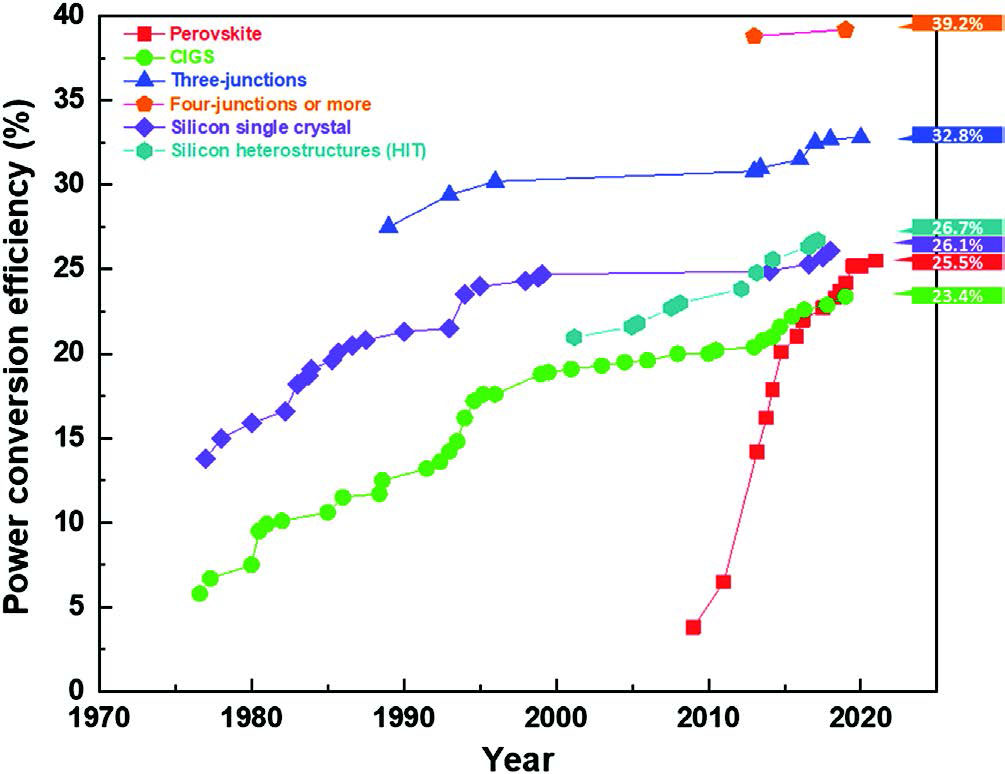| Jul 19, 2022 | |
Solar power for space applications |
|
| (Nanowerk Spotlight) The systems that generate power for spacecrafts either in Earth orbit or for other solar system and deep space destinations belong to the critical components of every mission. Depending on the the electric power demand of the mission, several technologies can be used to obtain an efficient power supply; each with their own advantages and disadvantages. | |
| For very short missions – weeks to months – electrochemical power sources such as non-rechargeable batteries and fuel cells can be employed. For longer missions, photovoltaic (PV) devices or nuclear power systems in conjunction with rechargeable batteries are so far the only available options to provide uninterrupted and stable electrical power. | |
| Satellites for inner planets missions (i.e., Mercury 0.4 AU, Venus 0.7 AU, Earth 1.0 AU, and Mars 1.5 AU; AU stands for Astronomical Unit and represents the average distance between the Sun and the Earth, i.e., ∼149.6 million km) usually employ solar cells. | |
| The huge improvements in photovoltaics over the past decades has paved the way for the exploitation of solar cells also for satellites traveling into deep space beyond Mars, by employing several strategies depending on the investigated technology. | |
| For instance, ESA has re-ignited space-based solar power research earlier this year with a campaign to solicit ideas to increase the feasibility of space-based solar power and support the development of clean energy. | |
 |
|
| Evolution of the power conversion efficiency of some PV technologies. (Reprinted with permission by Wiley-VCH Verlag) | |
| For instance, Stardust (sent to the comets Wild 2 and Tempel 1, 2.7 AU), Dawn (used for the exploration of the largest asteroid Vesta and the dwarf planet Ceres, 3.0 AU), Juno (currently studying Jupiter, 5.4 AU), and Rosetta (commissioned for analysis of the comet 67P/Churyumov-Gerasimenko, 5.3 AU) are solar-powered spacecraft designed to operate at great distances from the Sun. | |
| Usually, solar cells are heterostructured devices made up by several different materials piled up onto a substrate. Currently, the most used light harvesters in PV technologies for space applications are Si and semiconductors used for multi-junction solar cells such as Ge, III–V semiconductors like GaAs, InP, and their alloys (InGaP, InGaAs, InGaNAs, AlInGaP, and AlInGaAs). | |
| Space represents a challenging frontier for materials science and applications as the harsh conditions of the extraterrestrial environment require peculiar physicochemical properties. A recent review (Advanced Energy Materials, "Solar Energy in Space Applications: Review and Technology Perspectives") provides a summary of both commercially available PV technologies (Si-based solar cells and multi-junction solar cells) and some of the promising ones (CIGS-based solar cells and perovskite solar cells) for space missions. | |
| The first part of this review discusses the physical processes underlying the operation of an solar cells and the physical properties that guide the selection of semiconductor materials for the production of photovoltaic devices are discussed. | |
| In the second part, the authors describe the space environment and the specific requirements that solar cells must meet to withstand the rigid and harsh conditions in which they operates. | |
| The third part summarizes the performance of each type of space solar cell and the effects that the hostile space environment (considering, for example, high energy particle radiations and thermal fluctuations) has on the properties of different PV technologies. | |
| Following the increasing privatization of space missions, there is a great demand for cheaper PV technologies. In particular, Si-based solar cells are used for low power and short duration mission because of a good compromise between performances and production costs. | |
| Moreover, with the aim to reduce fabrication and maintenance costs while satisfying the requirements of lightweight and flexibility – thus paving the way to the manufacturing of flexible solar arrays – alternative PV technologies are being investigated. | |
| In their outlook for future materials that could be employed for space photovoltaics, the authors discuss two-dimensional (2D) nanomaterials such as graphene, transition metal dichalcogenides (TMDCs, e.g., MoS2, WS2, etc.) and transition metal carbides, nitrides, and carbonitrides (MXenes, for example Ti3C2Tx). Thanks to their outstanding optoelectronic, chemical, and mechanical properties, these materials have been proposed as transparent conductive electrodes, counter electrodes, charge transport layers, and interlayers. | |
| As a matter of fact, space agencies are already testing and proposing some 2D materials-based technologies for space missions: | |
|
|
|
| 2D materials also have been tested on Earth in space-relevant conditions, especially with regard to radiation resistance, as components of electronic devices such as transistors, sensors, etc. Surprisingly, despite the reduced thickness, 2D materials exhibit excellent resistance under bombardment with high energetic particles (including electrons, protons and γ-rays). | |
| These radiation tests indicate that devices based on 2D materials can withstand radiation fluences higher than those required in low earth orbits. Thus, since 2D materials show a high potential for both PV and radiation-resistant materials, 2D materials-based solar cells will be a likely future technology for space applications. | |
 By
Michael
Berger
– Michael is author of three books by the Royal Society of Chemistry:
Nano-Society: Pushing the Boundaries of Technology,
Nanotechnology: The Future is Tiny, and
Nanoengineering: The Skills and Tools Making Technology Invisible
Copyright ©
Nanowerk LLC
By
Michael
Berger
– Michael is author of three books by the Royal Society of Chemistry:
Nano-Society: Pushing the Boundaries of Technology,
Nanotechnology: The Future is Tiny, and
Nanoengineering: The Skills and Tools Making Technology Invisible
Copyright ©
Nanowerk LLC
|
|
|
Become a Spotlight guest author! Join our large and growing group of guest contributors. Have you just published a scientific paper or have other exciting developments to share with the nanotechnology community? Here is how to publish on nanowerk.com. |
|
